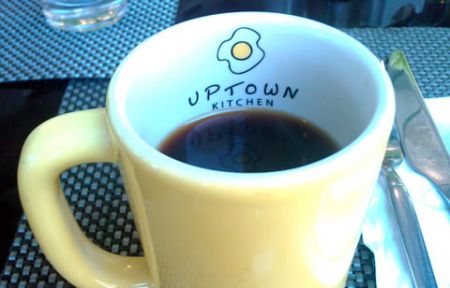Caffeinated Branding: Think Inside the Cup

Way back in 2005, in Can Caffeine Brain Boost Help Ad Recall?, I suggested that Starbucks could sell potent ads on their cups. This idea, though tongue-in-cheek in nature, was based on fMRI research that showed caffeine stimulated areas of the brain associated with memory:

Dr Florian Koppelstatter of the Medical University Innsbruck, Austria, found that caffeine affects distinct areas of the brain. This study is beleived to be the first to demonstrate a visible impact on the brain from caffeine. Subjects who had been given caffeine showed significantly more activity in the frontal lobe and the anterior cingulum – areas of the brain associated with memory and attention. Subjects who received a placebo showed no such impact.
Not long ago I visited an establishment that followed my advice, no doubt completely unwittingly. The Uptown Kitchen in Mishawaka, Indiana has a cute logo incorporating a colorful fried egg. While naturally they put their logo in the usual places around their establishment, they put it in a place well positioned to take advantage of any recall boost from caffeine: right inside the top of the cup, on both sides of the handle. Thus, whether you take a sip holding the cup with your right hand or left, you’ll see their logo. The outside of the cup was unadorned by advertising.
I’m sure that Uptown Kitchen didn’t invent this concept, and that many Neuromarketing readers have encountered cups with some kind of message on the inside. Nevertheless, I know that I’ve received dozens of coffee mugs as sales promotional items, and every single one had a plain interior and an exterior emblazoned with logos, slogans, phone numbers, and other ad messages.
Although a key advantage of the exterior labeling method is that the message is always visible, even when the cup is just sitting on the shelf, that very message makes the cup more likely to be stuffed in a drawer or discarded. Does an executive really want a coffee mug with a big ad for janitorial supplies sitting on her desk? Would an attractive cup with a small logo or message on the inside be more likely to be used? No two customers are alike, and there’s no research proving that coffee-cup advertising benefits from the caffeine-driven brain boost, but in some cases it may be time for advertisers to think inside the cup.
